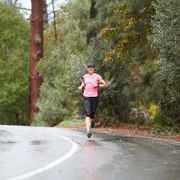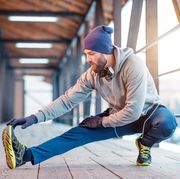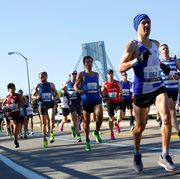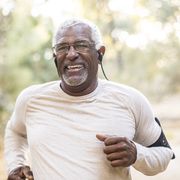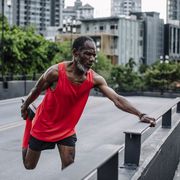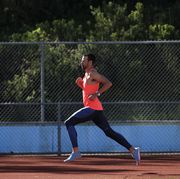Trends and fads work their way into the mainstream all the time. Think of Pet Rocks, the Paleolithic diet or Snuggies. But while the worst thing cuddling up in a blanket with sleeves can do is add a little extra lint to your dryer's trap, transitioning too quickly to the latest trend in running--minimalist footwear and barefoot running--can leave you hobbled for months. That's why runners who enter places like Foot RX in Asheville, N.C., will be heavily cautioned before going unshod.
"I want to accommodate the customer based on what [shoe] they've been in previously," says store owner Aaron Saft. "I always encourage a transition. I know there are those who can pull it off, but I don't want to open up susceptibility to injury on anyone." That susceptibility is heightened because a switch to minimalist footwear is often accompanied by a dramatic change in form. Landing on the forefoot or midfoot may be the most efficient and natural way to run, as experts like Harvard's Daniel Lieberman contend, yet the fact that minimalist runners still get injured frequently can't be discounted.
What follows is a self-help guide to injuries you may encounter when switching to minimalist footwear. "I think the key is education and letting [runners] know they have to focus on the form," says Saft, echoing the sentiments of the health professionals who contributed below. "The footwear does help, but it's really the form that's going to produce the results they're looking for."
More From Runner's World

Plantar Fasciitis
Achilles Tendinitis
Metatarsal Stress Fractures and Stress Reactions
Sesamoiditis and Sick Sesamoiditis Syndrome
Chronic Exertion Compartment Syndrome
Blisters
Prepatellar Bursitis
Navicular Stress Fracture
IS MINIMALISM WORTH THE RISK?
The Medical Community on Minimalism:
Reading through this litany of injury-related material, you might assume the consulted medical experts believe minimalism to be a dangerous trend that will leave you humbly hobbled. Nothing could be further from the truth. "I'm a big fan of minimalism," says Conenello. "I always try to get my patients into as minimalist a shoe as possible."
The potential benefits of minimalism and barefoot running are manyfold, our panel agreed. While increased efficiency, stronger feet, lower impact stress, a reduction in injury and better propreoception (muscle awareness while in motion) are all cited as reasons to make the switch, the most common refrain centers on basic biomechanics. "I think people are beginning to get more in touch with their form," says Conenello. "And that's the key."
How these benefits are manifest is a matter of personal taste and research. Fieseler believes barefoot strides may be sufficient to reap the rewards from a strength and efficiency standpoint, while Conenello has experimented in his own running with minimalist footwear. All believe runners stand to benefit from the paradigm shift in footwear, but that the shoes are only a small part of the equation.
"We're still in the mindset that there's going to be a silver bullet, one product that's going to do everything for us," says Wharton. "That's not necessarily the case."
WHAT YOU FEEL:
Plantar fasciitis "tends to be a burning, tearing type of pain on the bottom of the foot," says Cathy Fieseler, M.D., a sports medicine physician in Tyler, Texas. Typically, Fieseler says, "the first step out of bed is extremely painful, and then it starts to ease off." The severity of plantar fasciitis can be determined by how long the pain lingers after you wake. In extreme cases, pain is present any time you're weight-bearing. Pain will often increase after exercise, though usually not during it.
WHY YOU FEEL IT RUNNING MINIMALIST:
By far the most commonly cited area of injury associated with the minimalist running movement, the plantar fascia is asked to carry a heavy load when form and footwear changes are made. "The arch was designed as a spring, and if that spring isn't strong and flexible then you're not going to be able to translate the shock of running to a specific mechanical change," says Phil Wharton, a physiotherapist in eastern Pennsylvania and frequent Running Times contributor. Transitioning away from a heel-striking running form can overload the plantar fascia, which now plays a much larger role in absorbing impact forces. Without proper preparation, Wharton says, this can lead to almost immediate injury.
HOW TO SELF-TREAT:
Numerous noninvasive treatments exist. First and foremost, according to Fieseler, is to protect the affected fascia. This means no barefoot walking or running and adding more support to your running shoes. Rolling a frozen water bottle under the foot and taking NSAIDs such as ibuprofen throughout the day can help loosen the fascia and reduce inflammation. Sleeping in a night splint or Strassburg Sock can also help alleviate early morning tightness by keeping the foot actively stretched throughout the night. It's often possible to continue running through this injury if the plantar fascia responds to treatment.
To avoid future flare-ups, Fieseler recommends a program that actively strengthens the foot. This includes simple tasks like picking up marbles with your toes and performing towel crunches (an exercise where you place a towel on the floor and gradually pull it closer using your toes). Once you're healed, Fieseler recommends a slow return to minimalist running.
WHEN TO SEE A PROFESSIONAL:
If the pain remains constant throughout the day. Ruling out a more severe tear or other foot injury is imperative at this juncture. A medical practitioner may also be able to offer some treatments (including a cortisone shot) that aren't available at home.
WHAT YOU FEEL:
Pain or extreme tightness on the back of your heel, extending upward toward your calf muscles. Like plantar fasciitis, Fieseler says, the pain can include a burning or tearing sensation. Inflammation may also be present. The pain will generally increase with activity.
WHY YOU FEEL IT RUNNING MINIMALIST:
"You're not going to go to the gym for the first time and try to do 20,000 calf raises," says Fieseler, yet a runner who makes an immediate switch to minimalist footwear does precisely that on their first long run. The Achilles allows you to run on your forefoot or midfoot and absorbs the landing forces of each stride. If you're used to running in a traditional trainer with a built-up heel platform, the sudden difference in workload can be too much for a tendon that's been babied by modern running technology. "There needs to be a basic strength platform before we jump to minimalism," says Wharton. Absent that base, the Achilles often pays the price.
HOW TO SELF-TREAT:
Much like the plantar fascia, the Achilles tendon is often tightest and most prone to causing pain upon rising in the morning. For that reason, Fieseler recommends keeping a bath towel bedside to facilitate an early morning stretch. Icing the injury site is important, particularly after any type of exercise. Running through the injury is possible, but you should expect to reduce your volume (by 25-50 percent) and intensity (no hills) while rehabbing, Fieseler says.
To prevent recurrences, Wharton and Fieseler recommend preventative exercises, most notably full-range-of-motion calf raises done on the edge of a stair. To best prepare you for returning to minimalist running, Fieseler suggests gradually building up the speed of these calf raises to 90 times per minute on a single leg; this cadence is considered ideal when running.
WHEN TO SEE A PROFESSIONAL:
If the pain worsens significantly or becomes chronic. At that point it's necessary to rule out a heel stress fracture or torn tendon. Despite your minimalist preference, many physicians and podiatrists recommend orthotics to help relieve Achilles pain.
WHAT YOU FEEL:
Often beginning as a dull ache in the front or middle of the foot, a stress fracture or stress reaction of the metatarsals (five long bones in each foot) will quickly increase in pain when you're running or performing other weight-bearing activities. Pushing on the injury site or manipulating the injured toe will create immediate pain. The telltale sign that a metatarsal has fractured, according to Rob Conenello, D.P.M., the president-elect of the American Academy of Podiatric Sports Medicine, is pain that continues well after a run has ended. "If you run and the pain goes away, then maybe you're doing something wrong but you'll get used to it," he says. "If it's two hours or two days later and you still have pain in that area, then yes, we have a problem."
WHY YOU FEEL IT RUNNING MINIMALIST:
"A lot of the muscles that are supposed to be doing their job, like the glutes, hamstrings, hip rotators, and illiopsoas aren't doing their jobs," Wharton says of the average American runner. "This tends to lead to a harder foot plant." In traditional training shoes, a built-up heel and cushioned midsole potentially disperse much of the shock caused by poor biomechanics and limited flexibility. Absent that safety net, the major bones of the foot—most notably the metatarsals--become prime suspects to give out under the added stress of running in less shoe.
HOW TO SELF-TREAT:
Rest. Unlike with plantar fasciitis and Achilles tendinitis, it's not recommended that you attempt to run through a stress reaction or fracture, which can require four to eight weeks to heal properly. While casting is rare, many doctors recommend wearing a firm-soled shoe or hiking boot to minimize stress on the affected metatarsals. To maintain fitness during an injury layoff, consider non-weight-bearing activities such as water running, swimming, spinning, or working out on an elliptical.
Gradually working your way into minimalist running is one of the best ways to prevent the future onset of metatarsal stress fractures. Wharton recommends a six-week gradual buildup when transitioning into minimalist footwear, beginning with a few minutes of walking the first week, followed by the introduction of strength exercises, drills and strides, and finally a single mile of running. Stress fractures and reactions can also be caused by calcium and vitamin D deficiencies, so be sure to raise your intake of those nutrients both during your injury layoff and immediately thereafter.
WHEN TO SEE A PROFESSIONAL:
At first onset of bone pain. Because running on a stress fracture can lead to a complete break (a much more serious condition requiring casting), getting a proper diagnosis is important. The use of X-rays, CT scans, and MRIs can also help "rule out any 'zebras' like bone cancer" that may be causing the pain, says Conenello.
WHAT YOU FEEL:
A gradually increasing pain on the ball of your foot under the big toe. As the term applies to inflammation as well as fractures or other irritations, the sensation of sesamoiditis can vary widely. Bruising and discoloration are rare. Tendinitis may also be present, as the sesamoid bones reside completely within several tendons of the big toe.
WHY YOU FEEL IT RUNNING MINIMALIST:
"The sesamoids help absorb shock and distribute the forces acting on the big toe joint," says Brian Fullem, D.P.M., a Tampa-based podiatrist and former standout distance runner at Bucknell University. These forces greatly increase when a runner makes a hasty shift to forefoot running, causing distress in an area already susceptible to overuse injury.
HOW TO SELF-TREAT:
Treatment of sesamoiditis completely depends on its severity. In manageable cases, active rest is recommended in conjunction with ice and NSAIDs until the pain subsides. "Padding and orthotics to take the pressure off the area can also be effective," Fullem says, "but this is difficult to accomplish with a barefoot or minimalist runner." Perhaps the most effective way to reduce the risk of future injury is to evaluate your form. "I think [the cause] is runner error," Fullem says, "trying to run on the ball of the foot instead of landing more midfoot in a shoe with little to no cushioning."
WHEN TO SEE A PROFESSIONAL:
If the problem lingers or becomes steadily worse. "The blood supply is poor [in that part of the foot], so timely diagnosis is critical," Fullem says. Getting that diagnosis can be tricky, however, as X-rays often fail to show a fracture, and inflammation can be difficult to distinguish from a break. For this reason, a bone scan is highly recommended. In the case of chronic sesamoid pain lasting more than six months, known as "sick sesamoid syndrome," removing the afflicted sesamoid bone is recommended. In instances where there's no fracture, a cortisone injection in the joint space between the sesamoid and first metatarsal may offer relief.
WHAT YOU FEEL:
Tightness, burning, pressure, cramping and/or pain in the lower leg every time you exercise, most commonly around the calf and shin region. These symptoms are caused by a pressure buildup in any of the four compartments of the lower leg. The onset of these symptoms occurs at predictable intervals (for instance, 4 minutes into every run). Depending on which compartments are affected, you may also experience sudden fatigue on the top of your foot or ankle, numbness in the webbing near your big toe, or even drop foot. Visible swelling is also possible. These symptoms usually subside when you're done running. Runners "keep stretching it and it keeps coming back," Wharton says. "They'll try flexibility, they'll try massage, and it just seems like it's chronically tight."
WHY YOU FEEL IT RUNNING MINIMALIST:
During the course of a normal run, working muscles expand as blood flow rushes in to facilitate movement. For a person with chronic exertional compartment syndrome, the fascial sheath surrounding the muscles has become too inelastic and blood supply is cut off [known as ischemia], resulting in immediate pain. Wharton believes this condition may be more likely to affect minimalist runners because of the increased workload certain muscles face when a form change is made, notably the two major calf muscles (soleus and gastrocnemius). A lack of joint range of motion and minor muscle weaknesses in the foot, ankle and pelvis may also contribute.
HOW TO SELF-TREAT:
Traditionally, compartment syndrome has been viewed as a malady requiring surgery or several months of complete inactivity to heal, with a high rate of reoccurrence. Wharton, however, has had some success using physical therapy, particularly fascial release. "We want to explore all the noninvasive techniques first," he says. "A lot of times the soleus is weak. And the soleus is the prime pumper of blood to the lower legs." Unless told otherwise by your medical provider, running is not recommended.
Like most injuries associated with minimalist running, Wharton recommends working on increasing flexibility and strength at the injury site and making a very gradual return to minimalist running. He also advocates continued soft tissue release work (including learning self-treatment), particularly where the soleus and gastrocnemius converge.
WHEN TO SEE A PHYSICIAN:
While rehabilitation may be possible, seeing a physician is strongly recommended. At present the most definitive way to diagnose chronic exertional compartment syndrome is by inserting a slit catheter into the affected compartment and measuring the pressure before and during exercise. This diagnosis will ensure you are not suffering from another lower leg injury, such as severe shin splints, a tibial stress fracture, or soleus tear. The surest bet for a runner seeking a quick return to action is a fasciotomy, a surgical procedure in which pressure is released from the compartment through an incision. Runners are usually able to resume light jogging six weeks post-surgery, and full training by 12 weeks. Wharton highly recommends working in tandem with both a physician and physical therapist to lower the rate of reoccurrence and minimize unnecessary procedures.
BLISTERS
The "feel the ground" ethos of barefoot and minimalist running may lead to a greater understanding of form and biomechanics, but it also often leads to blisters, Conenello says. This is because most runners who train in true minimalist shoes such as the Vibram FiveFingers eschew socks in favor of a more natural fit. For feet unaccustomed to gravel, grit and hot pavement, that can spell the painful end of a run. Take a few days off to allow the blisters to heal, then dress them in sports tape before resuming activity. Also consider wearing toe socks. See a physician if you have any signs of infection.
PREPATELLAR BURSITIS
Usually an injury associated with contact sports and manual labor, prepatellar bursitis is a risk minimalist runners face, Wharton says. Symptoms include a thickening or protrusion below the knee cap, warmth and tenderness to the touch, and pain during running. Wharton recommends using a foam roller to break up the ischemia at the injury site, followed by a rehab program consisting of specific stretches and strengthening exercises. Icing the affected area and NSAIDs may also help relieve symptoms. If the bursitis persists, your doctor may recommend draining fluid from the bursa sac.
NAVICULAR STRESS FRACTURE
Best described as a nonspecific pain in the middle of the foot, navicular stress fractures are often difficult to diagnose and usually require a bone scan or CT scan to properly identify, Fullem says. Pain while crouching in a ski jump position or when pressure is applied to the "N spot" are telltale signs of this injury. Treatment consists of six to eight weeks of no weight-bearing activity (which may necessitate using crutches and a cast). A bone stimulator can be used to increase healing time.


